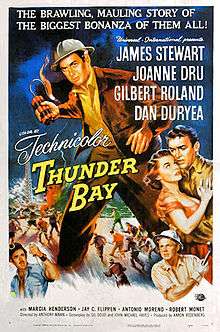Thunder Bay (film)
| Thunder Bay | |
|---|---|
 | |
| Directed by | Anthony Mann |
| Produced by | Aaron Rosenberg |
| Written by |
Gil Doud George W. George |
| Starring |
James Stewart Joanne Dru Gilbert Roland Dan Duryea |
| Music by | Frank Skinner |
| Cinematography | William H. Daniels |
| Edited by | Russell F. Schoengarth |
| Distributed by | Universal-International |
Release dates |
|
Running time | 103 minutes |
| Country | United States |
| Language | English |
| Box office | $2.4 million (US)[1] |
Thunder Bay is a 1953 American adventure film directed by Anthony Mann and starring James Stewart in their second non-western collaboration.
Plot
Following World War II, ex-Navy engineer Steve Martin (James Stewart) and his friend Johnny Gambi (Dan Duryea) come to Louisiana with dreams of wealth. They build an offshore oil drilling platform with the help of a large company, and find themselves in a lucrative business. However, local shrimp fishermen are hostile, feeling their livelihood is at risk. A further complication is the budding romance between Steve and the daughter of one of the shrimpers.
Cast
James Stewart as Steve Martin
Joanne Dru as Stella Rigaud
Gilbert Roland as Teche Bossier
Dan Duryea as Johnny Gambi
Jay C. Flippen as Kermit MacDonald
Harry Morgan as MacDonald's assistant
Production notes
- Production Dates: late September to mid-November 1952
- Filmed in 1.37 to 1 aspect ratio
- Released in 1.85 to 1 widescreen aspect ratio
- The film marked Universal's first use of stereophonic sound, which at the time was presentable only in select theaters. Some contemporary reviewers complained that the sound, with its use of three speakers, was loud and distracting.
- Originally planned to be photographed in 3-D
- Most of the picture was shot in Morgan City, LA, and some scenes were shot in New Orleans and on an oil-drilling barge thirty miles out in the Gulf of Mexico
- While filming scenes on location in Louisiana, Dan Duryea slipped and fell from the roof of a tugboat (which appears throughout the film). He suffered a broken rib, contusion and bruises, but was able to continue filming after a day or two of rest. [2]
Home video
The film is available as a standalone on VHS. Included in the James Stewart: Screen Legend Collection DVD box set (1.33:1 aspect ratio)
References
- ↑ 'The Top Box Office Hits of 1953', Variety, January 13, 1954
- ↑ Oct. 17, 1952 Article from Nevada State Journal
External links
| Wikimedia Commons has media related to Thunder Bay (film). |